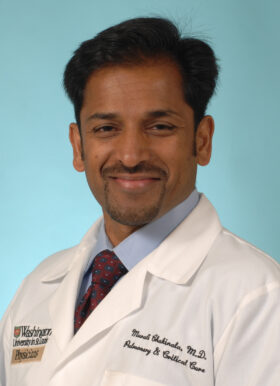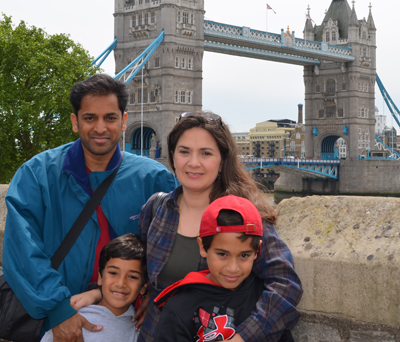Murali Chakinala, MD

Murali Chakinala, MD, is a professor in the Division of Pulmonary and Critical Care Medicine. His areas of specialty include pulmonary vascular diseases, including pulmonary hypertension and pulmonary arterio-venous malformations.
Dr. Chakinala sees patients at:
- The Lung Center in the Center for Advanced Medicine, 4921 Parkview Place, 8th floor, Suite B, St. Louis, MO 63110.
Please call 314-454-8917 for an appointment.
What happened in the course of schooling to influence you to choose your specialty?
My father was a pulmonologist, so I grew up around medicine. It was early in medical school when I became interested in internal medicine. I was led down the road to pulmonary critical care because I enjoyed taking care of patients with complex illnesses. Since the lungs are frequently implicated in many other diseases, pulmonologists are often required to take care of all aspects of a patient’s health.
What brought you to Washington University?
I met my wife during our medical residencies in Texas. We both had aspirations to stay in academics and wanted to find solid training programs – pulmonary for me and cardiology for her. Washington University is one of the few programs in the country (then and now) where both of these divisions are considered top tier programs.
We came for our interviews and meshed with the individual program directors at the time. Washington University’s reputation and the strengths of the individual programs brought us here — it seemed like the perfect fit.

Which aspect of your practice do you find most interesting?
I would broaden that question to include not just my practice, but my whole role here. What is most interesting is the ability to wear many different hats. Most importantly, as a clinician I take care of patients with very challenging and complex conditions. Many times these patients have seen other doctors and are desperate for help. It’s nice to be able to fulfill that role in the medical community.
I also enjoy the ability to work with residents, fellows and medical students – teaching them to be doctors and how to interact with patients. I’ve also been involved as the principal investigator (PI) in clinical research trials. In addition, my administrative roles give me the opportunity to work with a variety of health professionals. The many facets of my job are invigorating because each day is different.
What research are you involved in?
That’s really the exciting part of what I do. My interest is in pulmonary vascular diseases and in particular, pulmonary hypertension. It is an orphan (rare) disease. Landmark research led to approval of the first approved treatment for this disease 15 years ago – when I first entered pulmonary training. Prior to that, it was a fatal disease, and if you were lucky, you received a lung transplant.
Since that time, we’ve gone from one life-saving therapy to ten FDA-approved therapies. This gives us the ability to really make an impact on patient’s lives. We’ve taken a disease that was universally fatal and improved it to being a chronic, manageable ailment. There is still no cure , but we have more treatment options to extend people’s lives, help make them feel better, and often avoid a transplant.
We’re currently involved in numerous projects that are testing new drug compounds, new treatment strategies, or new drug delivery systems. We’re also participating in epidemiologic registries that are shaping our understanding of the affected population. So, we’re still learning, and I’m proud to be a participant in many of these research endeavors. My patients have benefited from the work of the physicians who came before me. It’s exciting that I’m now able to contribute to that body of work, which will continue to shape the lives of these patients over the next 10 to 25 years.
In the last decade, one half of all of the approved medical therapies for lung disease, including chronic obstructive pulmonary disease (COPD), asthma, lung cancer, have been in my area of interest — pulmonary hypertension. That’s a staggering statistic.
Could you talk about a few of the treatments?
There is a class of therapies we currently have (prostacyclins) that are unstable compounds and must be delivered through complex mechanisms – such as a continuous infusions or specialized nebulization devices. We’re on the brink of having drugs that deliver the same treatment – but in a simple pill form. That would be a huge advance because prostacyclins are the most effective drugs in pulmonary hypertension, but aren’t used as much as they should because of the complex delivery systems. The ability to administer in a pill form could allow us to treat people much earlier.
Up until now, all therapies have worked similarly – to dilate blood vessels, prevent clots from forming and slow down the growth of cells. These therapies haven’t cured our patients – they still have pulmonary hypertension that can often progress into heart failure. We are now actively investigating therapies that work in a different way, hopefully by reversing some of the changes in the blood vessels. We’re entering a new era in our field and will hopefully have medications that may ‘turn the clock back’ on the histologic changes encountered in the blood vessels.
What causes pulmonary hypertension?
The most common cause for pulmonary hypertension is an underlying lung or heart disease – such as emphysema, pulmonary fibrosis or diastolic heart failure. We don’t have any proven therapies for those conditions at this time.
I spend most of my time treating pulmonary arterial hypertension. In this disease there is typically nothing else wrong with the lungs or heart — it’s a problem with the blood vessels of the lungs, whichare progressively narrowed and even occluded. This can be a result of a genetic mutation, happen sporadically (idiopathic), or occur because of another systemic disease or process, such as infection from HIV, cirrhosis of the liver, or autoimmune diseases like scleroderma and lupus.
This gives me the opportunity to work with my colleagues in other specialties. In addition to pulmonary issues, I need to have an understanding of cardiology and rheumatology (two specialties I also considered as a resident). It’s ironic that I’m doing something that allows me to work in all the distinct areas I was interested in as a medical student.
Where are you from?
I was born in India and immigrated to the States when I was four years old. When my father was in training, we spent our early years in New York. I grew up in North Texas, where my family still lives.
Is there a particular award or achievement that is most gratifying?
Several years ago, the fellows honored me with a teaching award. That meant a great deal to me because I value teaching and the opportunity to shape the minds of future physicians.
In 2010, I was elected to the Scientific Leadership Council (SLC) of the Pulmonary Hypertension Association, which is an independent organization patient-advocacy group. It is at the heart of almost everything related to pulmonary hypertension in our country. The opportunity to serve on the SLC along with some of the giants of our field is an affirmation of my efforts.
What is the best advice you’ve ever received?
What you choose to do with your life should be decided by your interests and what you love — not by monetary requirements, geographic interests, or to satisfy others.
I’m not in the part of the country where I thought I’d be living –I had planned to settle in Texas with the rest of my family. But I love what I’m doing and it makes it exciting to come into work every day. It’s important to follow your heart to do what captivates you.
If you weren’t a doctor, what would you like to be doing?
If I wasn’t a doctor, I would like to be doing play-by-play for a sports network. I’m a huge sports enthusiast and would love to get paid to watch and announce sporting events.